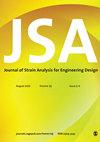Research on the stability analysis of milling of thin-walled parts based on the dynamic characteristics
IF 1.4
4区 工程技术
Q3 ENGINEERING, MECHANICAL
Journal of Strain Analysis for Engineering Design
Pub Date : 2022-07-26
DOI:10.1177/03093247221113231
引用次数: 0
Abstract
Chatter in thin-walled parts is easy to occur in the process of machining, so the analysis of the stability of thin-walled parts has always been a research hotspot. In this paper, considering the influence of cutter eccentricity on milling force first, the coefficients of milling force were able to be identified by combining the milling force model with genetic algorithm. The results show that this method can obtain the milling force coefficients only by one experiment, and the accuracy is higher. Then the tool point Frequency Response Function (FRF) for a given combination can be calculated by using the Receptance coupling substructure analysis (RCSA) method that uses Timoshenko beam theory. Finally, the milling system can be divided into three types by aspect ratio. That is, when aspect ratio is less than 0.03, the system is considered to be a rigid tool-flexible workpiece system, but aspect ratio is between 0.03 and 0.2, the system is considered to be a flexible tool-flexible system, then aspect ratio is greater than 0.2, the system is considered to be a flexible cutter-rigid workpiece system.基于动态特性的薄壁零件铣削稳定性分析研究
薄壁零件在加工过程中容易产生颤振,因此薄壁零件的稳定性分析一直是一个研究热点。本文首先考虑了刀具偏心对铣削力的影响,将铣削力模型与遗传算法相结合,确定了铣削力系数。结果表明,该方法只需一次实验即可得到铣削力系数,且精度较高。然后采用基于Timoshenko梁理论的接收耦合子结构分析(RCSA)方法计算给定组合的工具点频响函数(FRF)。最后,根据纵横比将铣削系统分为三种类型。即当纵横比小于0.03时,系统被认为是刚性刀具-柔性工件系统,而纵横比在0.03 ~ 0.2之间时,系统被认为是柔性刀具-柔性系统,那么纵横比大于0.2时,系统被认为是柔性刀具-刚性工件系统。
本文章由计算机程序翻译,如有差异,请以英文原文为准。
求助全文
约1分钟内获得全文
求助全文
来源期刊

Journal of Strain Analysis for Engineering Design
工程技术-材料科学:表征与测试
CiteScore
3.50
自引率
6.20%
发文量
25
审稿时长
>12 weeks
期刊介绍:
The Journal of Strain Analysis for Engineering Design provides a forum for work relating to the measurement and analysis of strain that is appropriate to engineering design and practice.
"Since launching in 1965, The Journal of Strain Analysis has been a collegiate effort, dedicated to providing exemplary service to our authors. We welcome contributions related to analytical, experimental, and numerical techniques for the analysis and/or measurement of stress and/or strain, or studies of relevant material properties and failure modes. Our international Editorial Board contains experts in all of these fields and is keen to encourage papers on novel techniques and innovative applications." Professor Eann Patterson - University of Liverpool, UK
This journal is a member of the Committee on Publication Ethics (COPE).
 求助内容:
求助内容: 应助结果提醒方式:
应助结果提醒方式:


